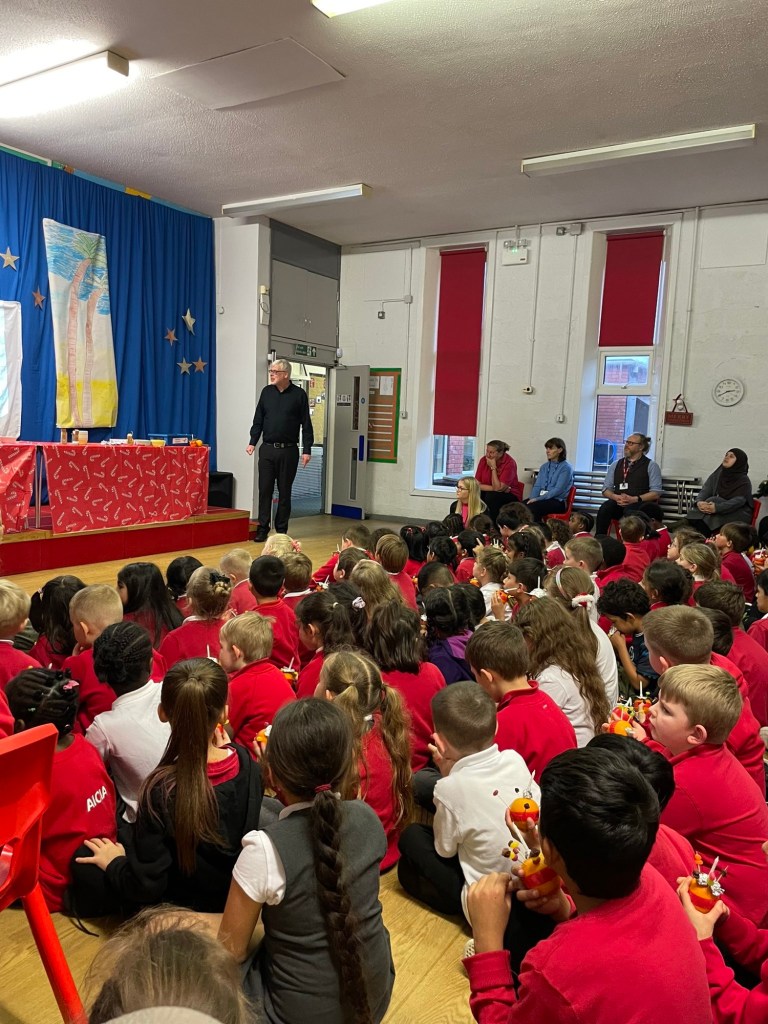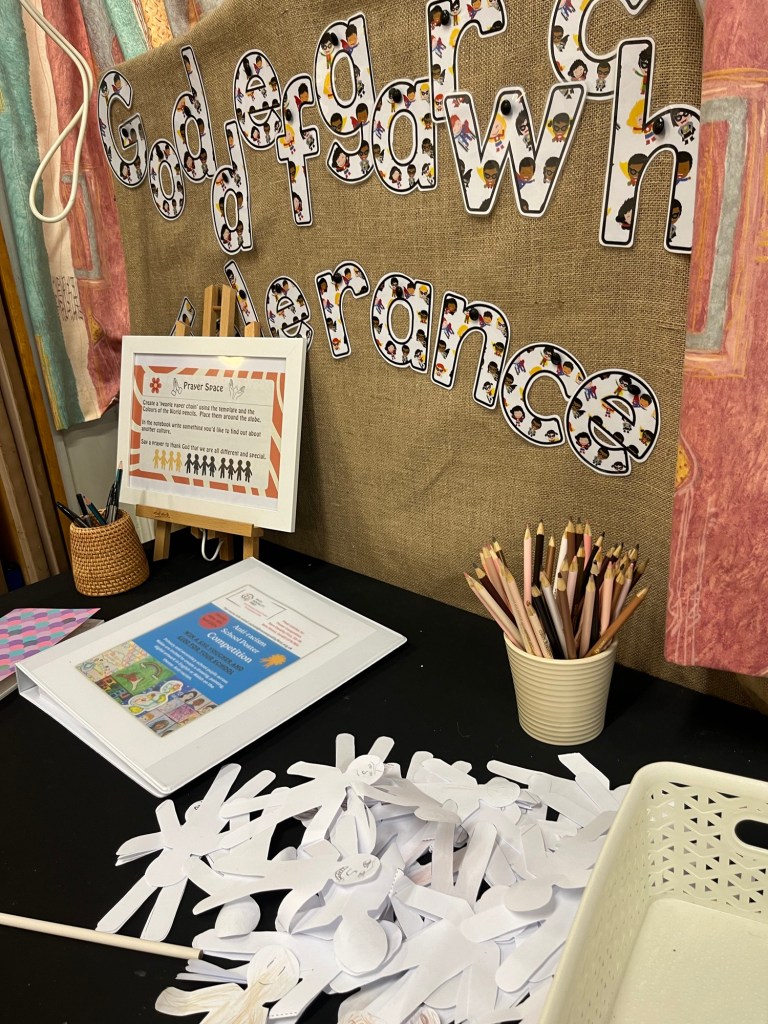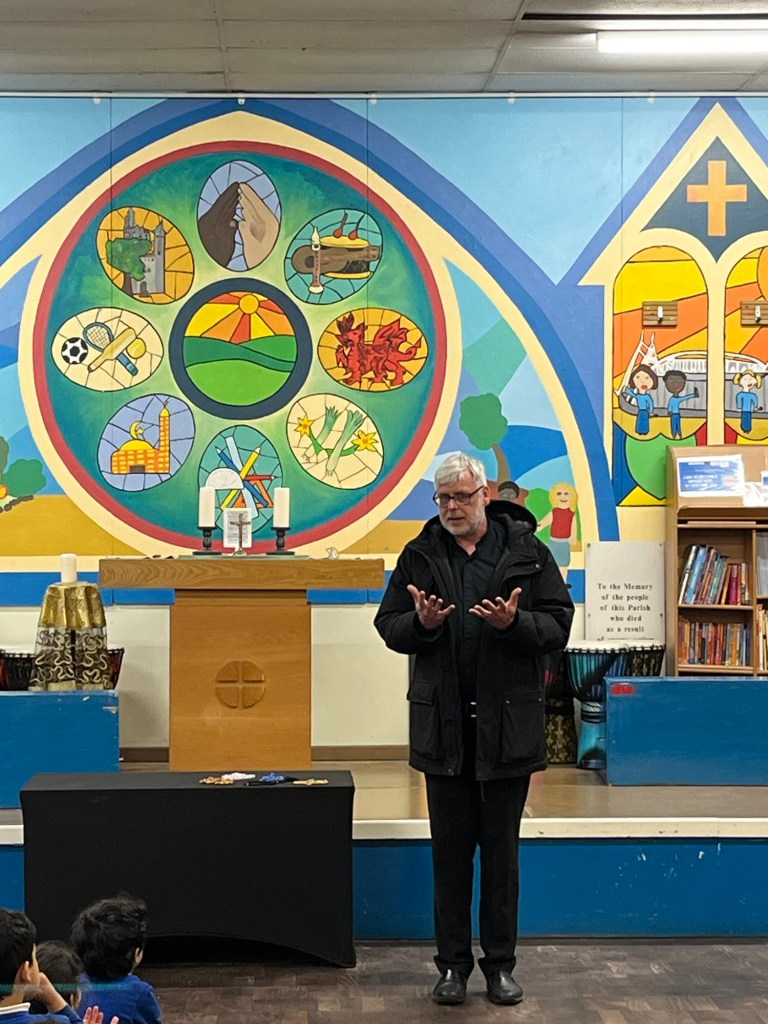Our Church Schools are amazing communities of children, staff and families, a place where we make connections and try to understand each other better. Here’s a reflection on our experience of prayer and worship with children in school
I wait in St Mary’s School Hall for the children to arrive. I twiddle my fingers and thumbs, turn the ring around my finger, a gift from my mother many years ago. It’s a habit I’ve noticed myself doing, as I turn it round and round in circles.
Some of the Year 6 pupils who have been helping to prepare the space for Collective Worship, and place chairs for the staff and their own classmates, stop to look at the visual aids I’ve brought in. Rosary Beads of different shapes and sizes, a Jesus Rope with its tied knots, and some Muslim Prayer Beads.
They explore them, decide to order them in size. One of the children is Sikh. I ask him about prayer beads in the Sikh faith, but he doesn’t seem to know about them, but he is keen to show me the jewellery they wear, lifts the sleeve of his jumper to show me the bangle, the Kara, a sign of unbreakable attachment and commitment to God.

Slowly, the hall begins to fill up with lines of children escorted by staff and calming music. Most of the children sat in front of me now are Muslim, over 80 per cent. There are Hindus too, and I see a few members of the church congregation, all recently baptized at Easter. They smile.
It’s Monday afternoon, and I lead worship here from time to time through the term. Over the river in St Paul’s Primary School, I also lead collective worship each week, as well as Mass with a different class each time before I scurry back to Butetown for Mass with some of the children of St Mary’s where the arrangement is slightly different. It’s the same children each week, whilst the Muslim children remain in school for their own focussed time together.
At St Paul’s, we’ve also been able to celebrate Masses with the whole school present or explored the Stations of the Cross together in classes back in Holy Week. Different things are possible.

Each school is distinctive in its life of prayer and worship, in its religious expression and Christian identity. Both schools embrace and respect the faith of all its pupils within a Christian environment, do it in their own unique way. They have their own pattern of prayer, adopt their own unique school prayer.
“One day, some years ago, I had a large glass cookie jar,” I tell the children in front of me. “There weren’t any cookies in it. I like cookies, so they didn’t last long. But I used the jar to collect my loose change. Ones and twos, lots of coppers and a few silver pieces too. Every day, my loose change was dropped into the cookie jar. I didn’t pay much attention to it.
And then, one day, my mother paid a visit, told me I should count it. I said, “If you count it, you can keep it.” I returned home later that day. She was surrounded by neat stacks of coins. “£450 pounds,” she exclaimed. Sometimes, we don’t realise how much or what we have until we count it!”
In his book, ‘Supercommunicators,’ Charles Duhigg talks of “an essential truth: to communicate with someone we must connect with them. When we absorb what someone is saying and they comprehend what we say it’s because our brains have, to some degree, aligned. When we start thinking alike, we understand each other better.”

I show them the rosary beads, tell them that counting prayers with beads is common to many different religions, that the old English words ‘bede’ actually means ‘a prayer.’
We compare the beads, different shapes and sizes and materials. I show them the Muslim prayer beads. “How many of you have some of these?” I ask. Many raise their hands. I tell them a Muslim friend gave me these.
We have connected.
That’s what we do. We make connections, find the common ground which we can inhabit, discover some shared thing so that we can move on together. Carve out a space of openness where we can learn from one another, communicate with one another, explore the world together, discover new possibilities, understand each other better.

I’m not an ardent adherent to the law when it comes to Collective worship in State schools. It’s not a hill I will die on. I don’t mind that many people think the law is outdated, non-representative, exclusive, and want it changed. I don’t think that we as Christians can expect State schools to do our work for us, expect teachers who have no faith to teach children how to pray in our faith. But if that’s your hill, I’m happy for you to keep fighting for it.
But here I am, in a Voluntary Aided Faith School of the Church in Wales, with a distinct Christian character embracing a diverse group of children, and staff too.
And so we try to make connections.

On Wednesday mornings we celebrate our School Masses. In St Paul’s Church there will be children from all the different faiths there. Each child will be involved in their own way. Some will sit towards the front and participate more openly, some will receive Holy Communion, others will read or lead the prayers. Others will sit further back, be given the space to sit comfortably with their own identity and to grow up with what brings them meaning.
When I speak, I try to find those moments of connection, a means of beginning to understand one another, acknowledge our differences, and not make assumptions about their own experience of prayer and spirituality, their own faith and religious identity.
Last week at St Paul’s it was all about wasted gifts and talents. I told them how I wasted one of my talents when I was younger. I gave up running, racing, sprinting. I hold the unlit candle which they presented at the beginning of Mass, the symbol for that week’s celebration. “What’s the point of a candle if you don’t light it? What’s the point of our gifts if we don’t use them?” I talk about Jesus. I can do this now – we have made connections.

Meanwhile, back in St Mary’s School Hall, we turn to our hands, count our fingers. What things can we count? What if we counted our blessings? Would we have enough fingers and thumbs?
They share some of their blessings, from shared toys to food, from being loved to going to school, from bed time to play time. We begin to run out of fingers.
“Are we allowed one of those?” asks the Sikh lad pointing to the rosary before he leaves.
“Oh, that’s not for me to decide unfortunately,” I say. “That’s a conversation to have with your family.”
He smiles, is content with that.
I recall a conversation with him on a long journey to London last year on a School Trip. He told me about his hair, hidden away beneath his dastar, how long it was, why he didn’t cut it. “It belongs to God,’ he said. I could connect with that. We understood each other better then.
By the way, my mother insisted that she didn’t want that stack of coins. She bagged them up, ready for me to take to the Bank. It was another day, like today, when I could have done with a few more fingers to count my blessings or maybe pick up the beads and just go round in circles.

Thank you Father Dean, I enjoyed reading this, particularly as someone who is also trying to make connections.
LikeLike